sensor SMART FORTWO COUPE 2010 Owners Manual
[x] Cancel search | Manufacturer: SMART, Model Year: 2010, Model line: FORTWO COUPE, Model: SMART FORTWO COUPE 2010Pages: 216, PDF Size: 9.7 MB
Page 6 of 216
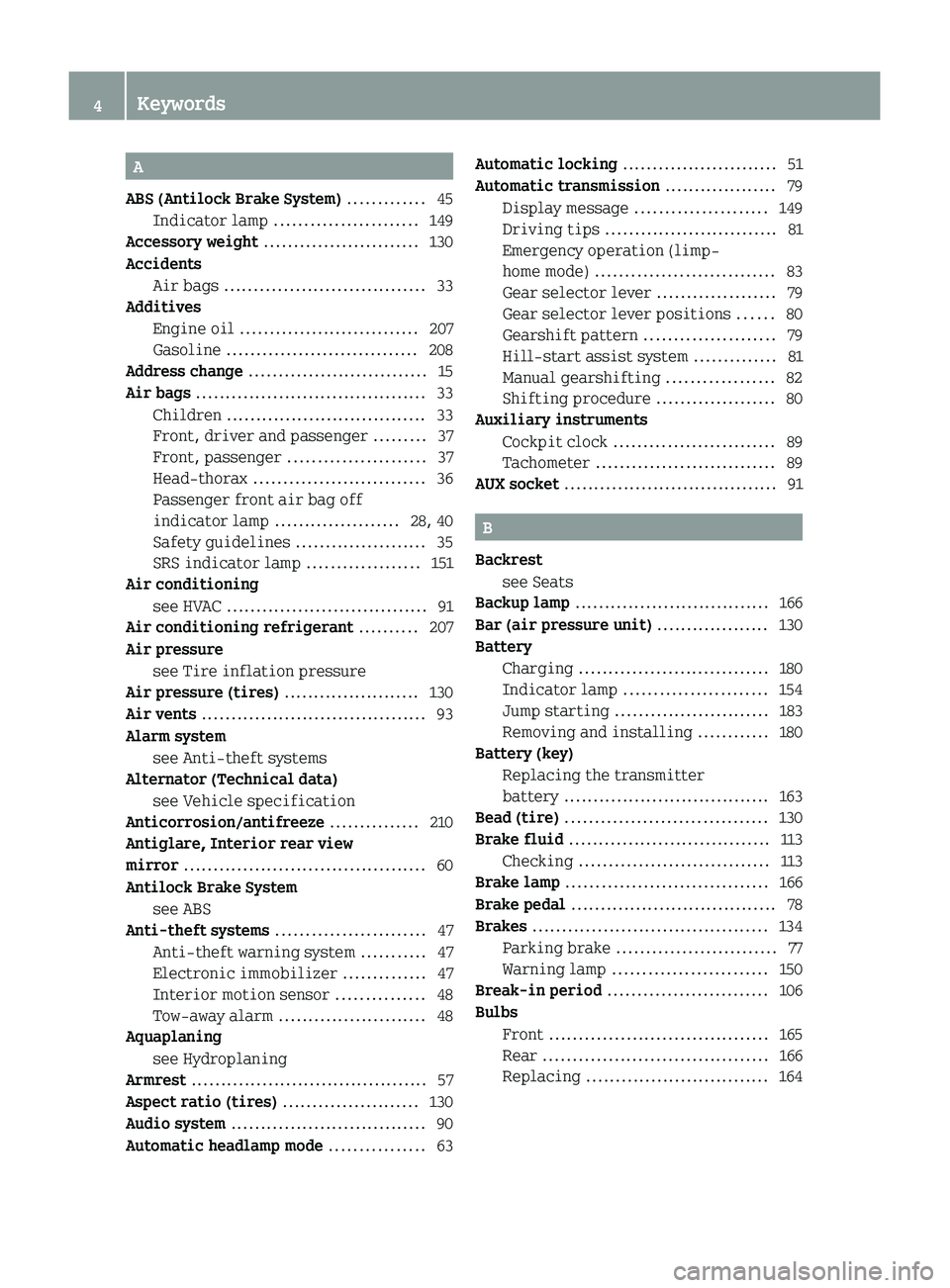
A
ABS (Antilock Brake System) ............. 45
Indicator lamp ........................ 149
Accessory weight .......................... 130
Accidents
Air bags .................................. 33
Additives
Engine oil .............................. 207
Gasoline ................................ 208
Address change .............................. 15
Air bags ....................................... 33
Children .................................. 33
Front, driver and passenger .........37
Front, passenger ....................... 37
Head-thorax ............................. 36
Passenger front air bag off
indicator lamp ..................... 28, 40
Safety guidelines ......................35
SRS indicator lamp ...................151
Air conditioning
see HVAC .................................. 91
Air conditioning refrigerant .......... 207
Air pressure see Tire inflation pressure
Air pressure (tires) ....................... 130
Air vents ...................................... 93
Alarm system see Anti-theft systems
Alternator (Technical data)
see Vehicle specification
Anticorrosion/antifreeze ............... 210
Antiglare, Interior rear view
mirror ......................................... 60
Antilock Brake System see ABS
Anti-theft systems ......................... 47
Anti-theft warning system ...........47
Electronic immobilizer ..............47
Interior motion sensor ...............48
Tow-away alarm ......................... 48
Aquaplaning
see Hydroplaning
Armrest ........................................ 57
Aspect ratio (tires) ....................... 130
Audio system ................................. 90
Automatic headlamp mode ................ 63Automatic locking .......................... 51
Automatic transmission ................... 79
Display message ...................... 149
Driving tips ............................. 81
Emergency operation (limp-
home mode) .............................. 83
Gear selector lever ....................79
Gear selector lever positions ......80
Gearshift pattern ...................... 79
Hill-start assist system ..............81
Manual gearshifting ..................82
Shifting procedure ....................80
Auxiliary instruments
Cockpit clock ........................... 89
Tachometer .............................. 89
AUX socket .................................... 91
B
Backrest see Seats
Backup lamp ................................. 166
Bar (air pressure unit) ................... 130
Battery
Charging ................................ 180
Indicator lamp ........................ 154
Jump starting .......................... 183
Removing and installing ............180
Battery (key)
Replacing the transmitter
battery ................................... 163
Bead (tire) .................................. 130
Brake fluid .................................. 113
Checking ................................ 113
Brake lamp .................................. 166
Brake pedal ................................... 78
Brakes ........................................ 134
Parking brake ........................... 77
Warning lamp .......................... 150
Break-in period ........................... 106
Bulbs
Front ..................................... 165
Rear ...................................... 166
Replacing ............................... 164
4Keywords451_AKB; 3; 22, en-USd2ureepe,Version: 2.11.8.12009-07-27T09:36:34+02:00 - Seite 4
Page 9 of 216
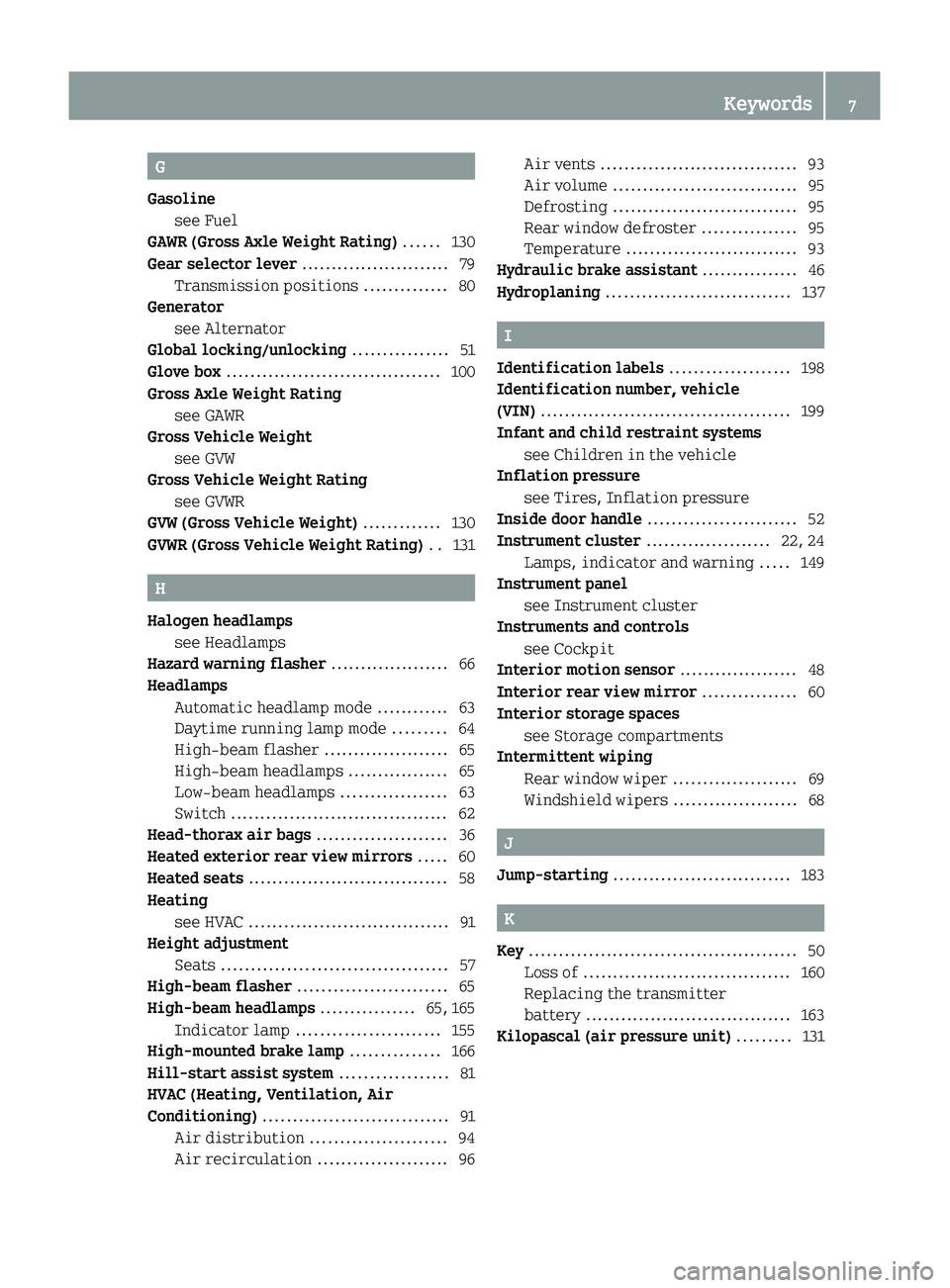
G
Gasoline see Fuel
GAWR (Gross Axle Weight Rating) ...... 130
Gear selector lever ......................... 79
Transmission positions ..............80
Generator
see Alternator
Global locking/unlocking ................ 51
Glove box .................................... 100
Gross Axle Weight Rating see GAWR
Gross Vehicle Weight
see GVW
Gross Vehicle Weight Rating
see GVWR
GVW (Gross Vehicle Weight) ............. 130
GVWR (Gross Vehicle Weight Rating) .. 131
H
Halogen headlamps see Headlamps
Hazard warning flasher .................... 66
Headlamps
Automatic headlamp mode ............63
Daytime running lamp mode .........64
High-beam flasher .....................65
High-beam headlamps ................. 65
Low-beam headlamps ..................63
Switch ..................................... 62
Head-thorax air bags ...................... 36
Heated exterior rear view mirrors ..... 60
Heated seats .................................. 58
Heating
see HVAC .................................. 91
Height adjustment
Seats ...................................... 57
High-beam flasher ......................... 65
High-beam headlamps ................ 65, 165
Indicator lamp ........................ 155
High-mounted brake lamp ............... 166
Hill-start assist system .................. 81
HVAC (Heating, Ventilation, Air
Conditioning) ............................... 91
Air distribution ....................... 94
Air recirculation ...................... 96
Air vents ................................. 93
Air volume ............................... 95
Defrosting ............................... 95
Rear window defroster ................95
Temperature ............................. 93
Hydraulic brake assistant ................ 46
Hydroplaning ............................... 137
I
Identification labels .................... 198
Identification number, vehicle
(VIN) .......................................... 199
Infant and child restraint systems see Children in the vehicle
Inflation pressure
see Tires, Inflation pressure
Inside door handle ......................... 52
Instrument cluster ..................... 22, 24
Lamps, indicator and warning .....149
Instrument panel
see Instrument cluster
Instruments and controls
see Cockpit
Interior motion sensor .................... 48
Interior rear view mirror ................ 60
Interior storage spaces see Storage compartments
Intermittent wiping
Rear window wiper .....................69
Windshield wipers .....................68
J
Jump-starting .............................. 183
K
Key ............................................. 50
Loss of ................................... 160
Replacing the transmitter
battery ................................... 163
Kilopascal (air pressure unit) ......... 131
Keywords7451_AKB; 3; 22, en-USd2ureepe,Version: 2.11.8.12009-07-27T09:36:34+02:00 - Seite 7
Page 11 of 216
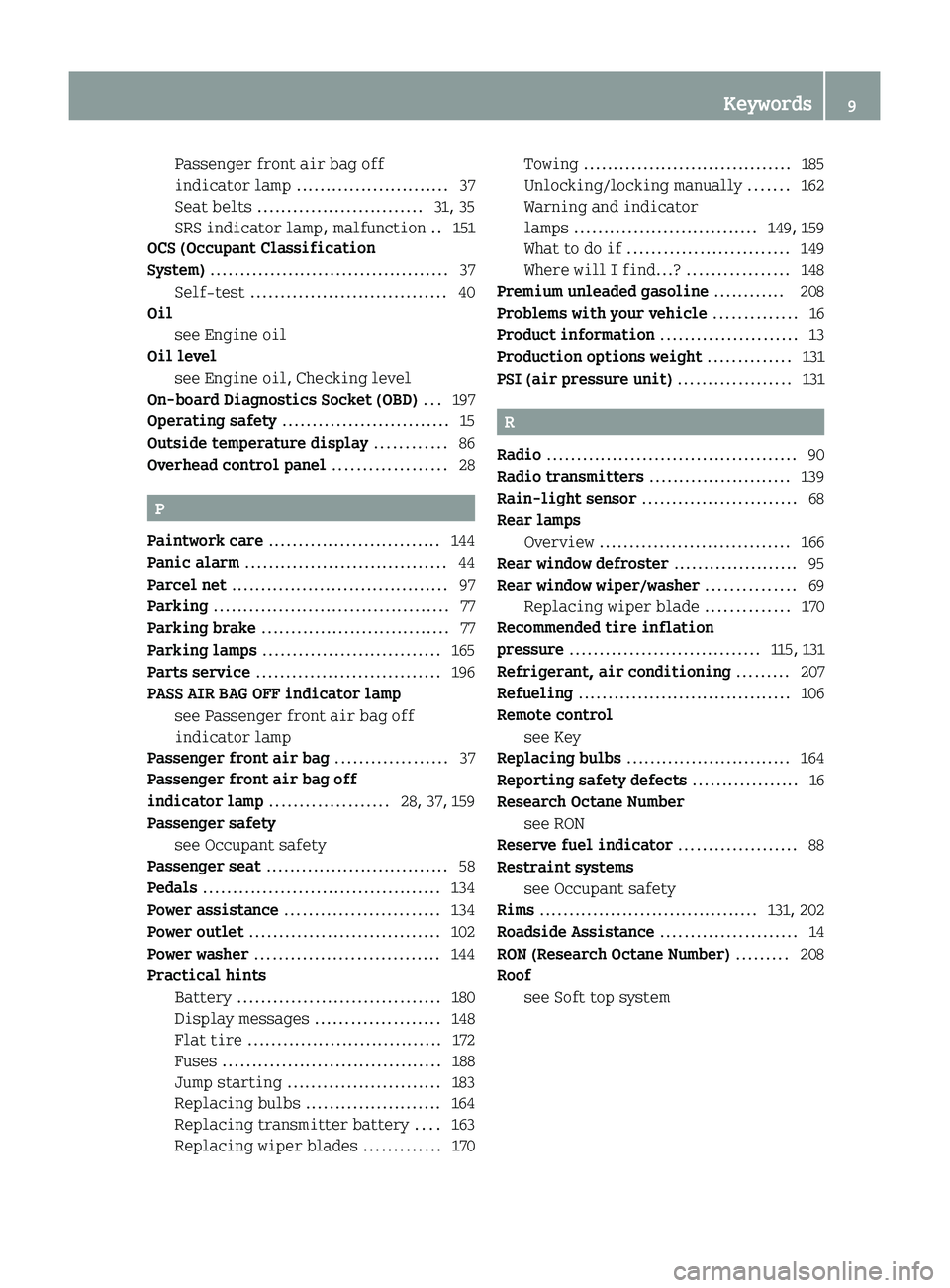
Passenger front air bag off
indicator lamp .......................... 37
Seat belts ............................ 31, 35
SRS indicator lamp, malfunction .. 151
OCS (Occupant Classification
System) ........................................ 37
Self-test ................................. 40
Oil
see Engine oil
Oil level
see Engine oil, Checking level
On-board Diagnostics Socket (OBD) ... 197
Operating safety ............................ 15
Outside temperature display ............ 86
Overhead control panel ................... 28
P
Paintwork care ............................. 144
Panic alarm .................................. 44
Parcel net ..................................... 97
Parking ........................................ 77
Parking brake ................................ 77
Parking lamps .............................. 165
Parts service ............................... 196
PASS AIR BAG OFF indicator lamp see Passenger front air bag off
indicator lamp
Passenger front air bag ................... 37
Passenger front air bag off
indicator lamp .................... 28, 37, 159
Passenger safety see Occupant safety
Passenger seat ............................... 58
Pedals ........................................ 134
Power assistance .......................... 134
Power outlet ................................ 102
Power washer ............................... 144
Practical hints
Battery .................................. 180
Display messages .....................148
Flat tire ................................. 172
Fuses ..................................... 188
Jump starting .......................... 183
Replacing bulbs ....................... 164
Replacing transmitter battery ....163
Replacing wiper blades .............170
Towing ................................... 185
Unlocking/locking manually .......162
Warning and indicator
lamps ............................... 149, 159
What to do if ........................... 149
Where will I find...? .................148
Premium unleaded gasoline ............ 208
Problems with your vehicle .............. 16
Product information ....................... 13
Production options weight .............. 131
PSI (air pressure unit) ................... 131
R
Radio .......................................... 90
Radio transmitters ........................ 139
Rain-light sensor .......................... 68
Rear lamps
Overview ................................ 166
Rear window defroster ..................... 95
Rear window wiper/washer ............... 69
Replacing wiper blade ..............170
Recommended tire inflation
pressure ................................ 115, 131
Refrigerant, air conditioning ......... 207
Refueling .................................... 106
Remote control see Key
Replacing bulbs ............................ 164
Reporting safety defects .................. 16
Research Octane Number see RON
Reserve fuel indicator .................... 88
Restraint systems see Occupant safety
Rims ..................................... 131, 202
Roadside Assistance ....................... 14
RON (Research Octane Number) ......... 208
Roof see Soft top system
Keywords9451_AKB; 3; 22, en-USd2ureepe,Version: 2.11.8.12009-07-27T09:36:34+02:00 - Seite 9
Page 14 of 216
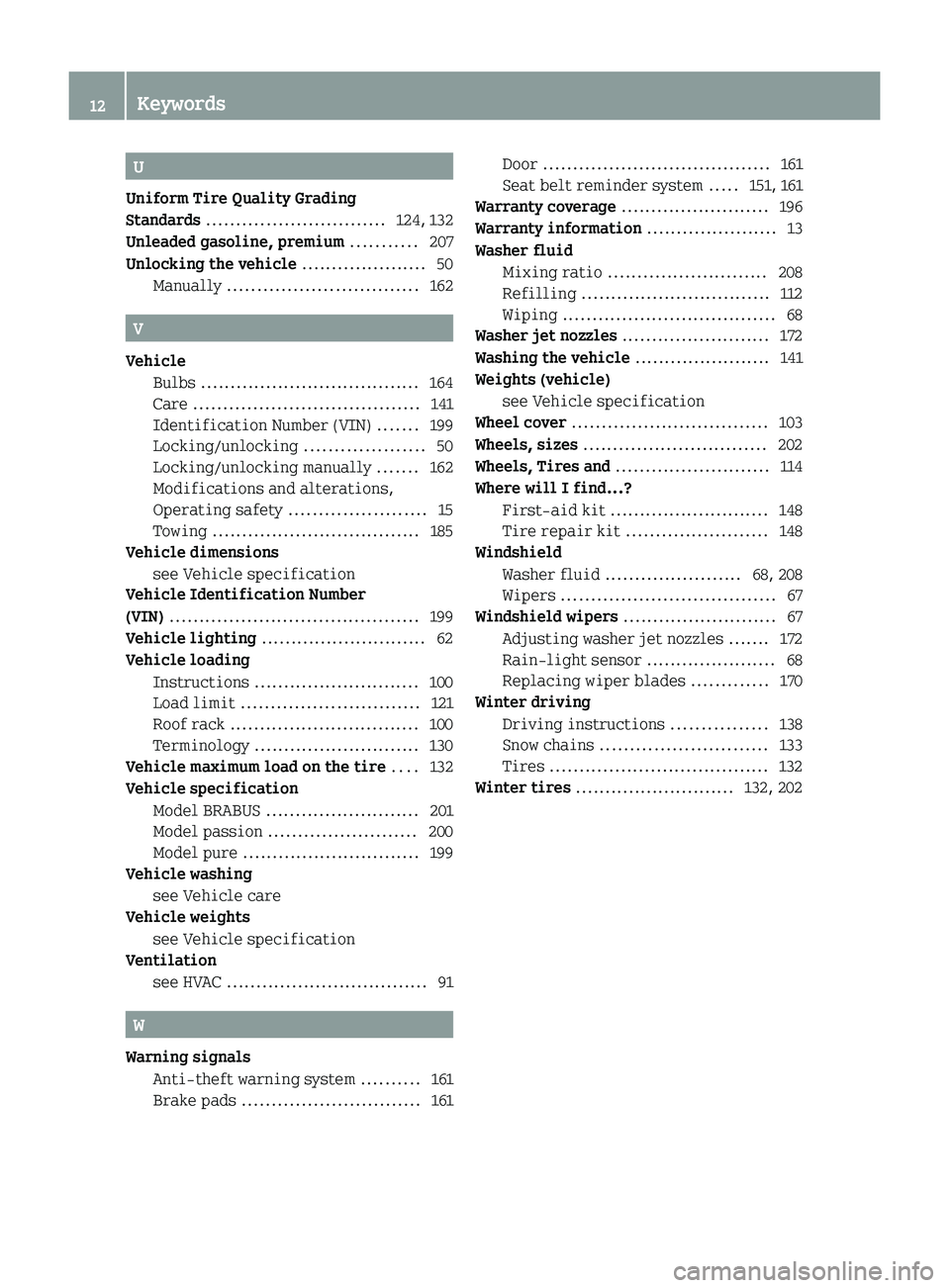
U
Uniform Tire Quality Grading
Standards .............................. 124, 132
Unleaded gasoline, premium ........... 207
Unlocking the vehicle ..................... 50
Manually ................................ 162
V
Vehicle
Bulbs ..................................... 164
Care ...................................... 141
Identification Number (VIN) .......199
Locking/unlocking ....................50
Locking/unlocking manually .......162
Modifications and alterations,
Operating safety ....................... 15
Towing ................................... 185
Vehicle dimensions
see Vehicle specification
Vehicle Identification Number
(VIN) .......................................... 199
Vehicle lighting ............................ 62
Vehicle loading
Instructions ............................ 100
Load limit .............................. 121
Roof rack ................................ 100
Terminology ............................ 130
Vehicle maximum load on the tire .... 132
Vehicle specification
Model BRABUS .......................... 201
Model passion ......................... 200
Model pure .............................. 199
Vehicle washing
see Vehicle care
Vehicle weights
see Vehicle specification
Ventilation
see HVAC .................................. 91
W
Warning signals
Anti-theft warning system ..........161
Brake pads .............................. 161
Door ...................................... 161
Seat belt reminder system .....151, 161
Warranty coverage ......................... 196
Warranty information ...................... 13
Washer fluid
Mixing ratio ........................... 208
Refilling ................................ 112
Wiping .................................... 68
Washer jet nozzles ......................... 172
Washing the vehicle ....................... 141
Weights (vehicle) see Vehicle specification
Wheel cover ................................. 103
Wheels, sizes ............................... 202
Wheels, Tires and .......................... 114
Where will I find...?
First-aid kit ........................... 148
Tire repair kit ........................ 148
Windshield
Washer fluid ....................... 68, 208
Wipers .................................... 67
Windshield wipers .......................... 67
Adjusting washer jet nozzles ....... 172
Rain-light sensor ...................... 68
Replacing wiper blades .............170
Winter driving
Driving instructions ................138
Snow chains ............................ 133
Tires ..................................... 132
Winter tires ........................... 132, 20212Keywords451_AKB; 3; 22, en-USd2ureepe,Version: 2.11.8.12009-07-27T09:36:34+02:00 - Seite 12
Page 28 of 216
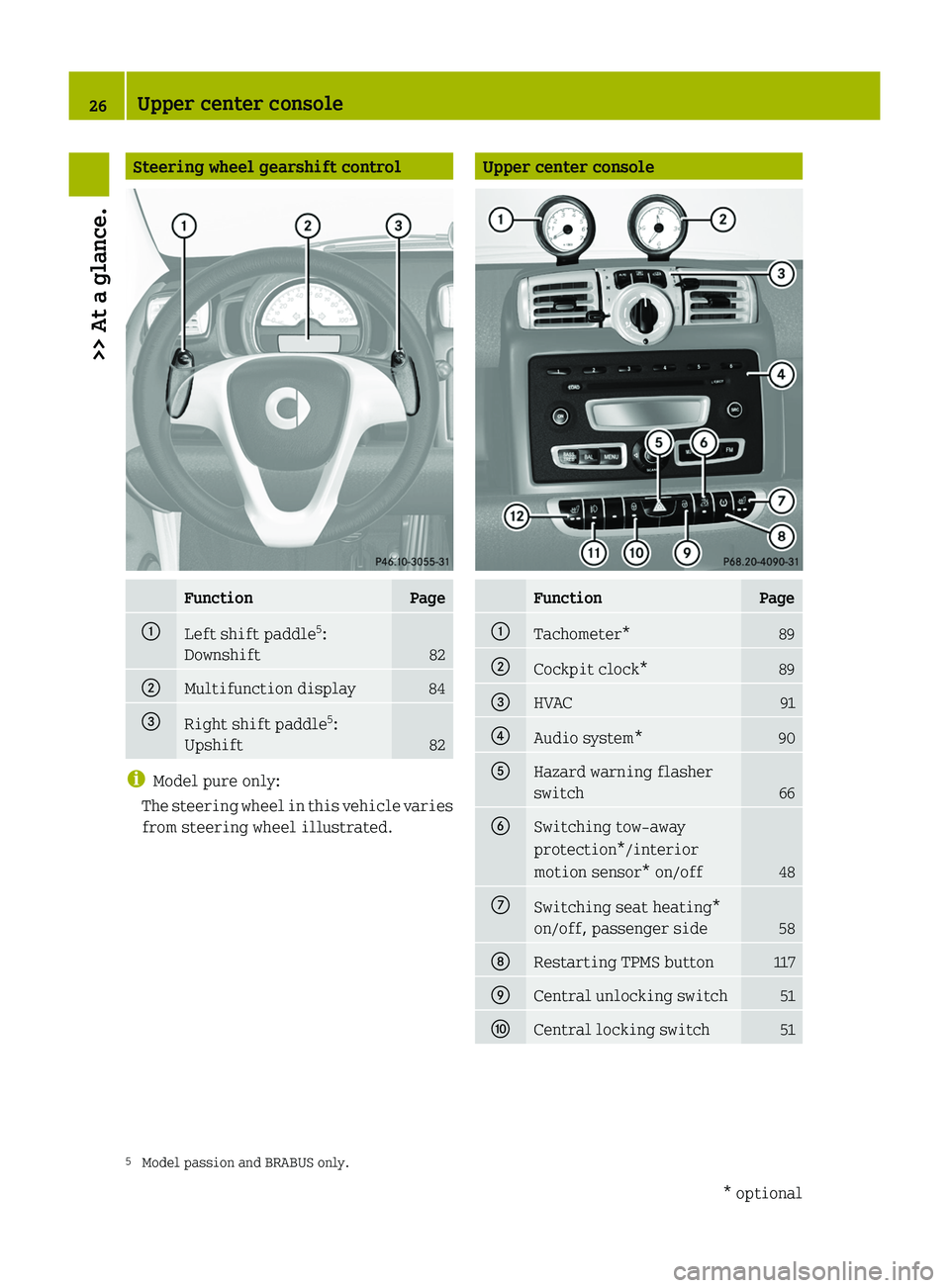
Steering wheel gearshift controlFunctionPage0046Left shift paddle5
:
Downshift
82
0047Multifunction display84008ARight shift paddle 5
:
Upshift
82
i Model pure only:
The steering wheel in this vehicle varies
from steering wheel illustrated.
Upper center consoleFunctionPage0046Tachometer*890047Cockpit clock*89008AHVAC910088Audio system*900086Hazard warning flasher
switch
66
0087Switching tow-away
protection*/interior
motion sensor* on/off
48
006ESwitching seat heating*
on/off, passenger side
58
006FRestarting TPMS button1170070Central unlocking switch510071Central locking switch515 Model passion and BRABUS only.26Upper center console>> At a glance.* optional451_AKB; 3; 22, en-USd2ureepe,Version: 2.11.8.12009-07-27T09:36:34+02:00 - Seite 26
Page 32 of 216
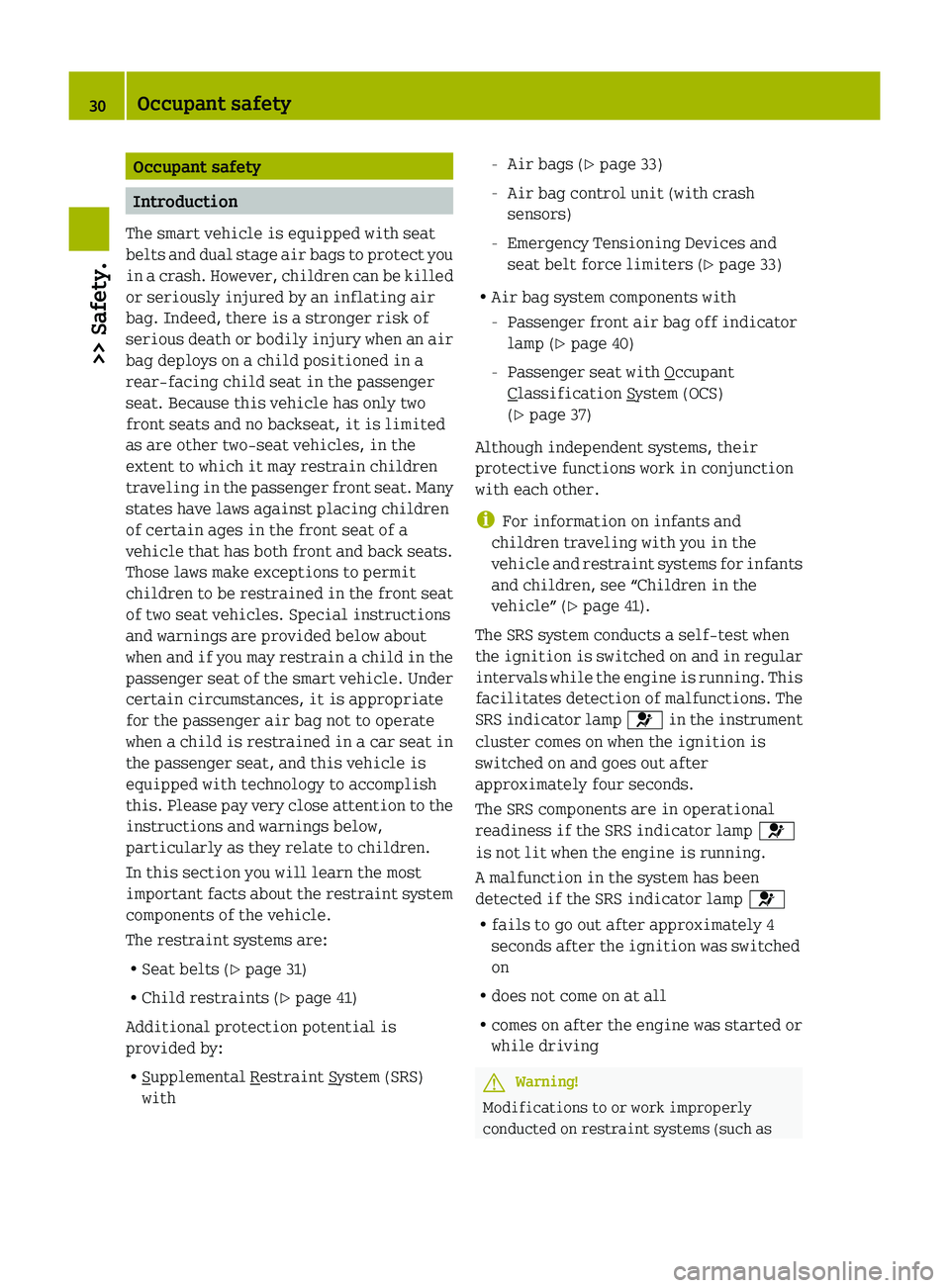
Occupant safety
Introduction
The smart vehicle is equipped with seat
belts and dual stage air bags to protect you
in a crash. However, children can be killed
or seriously injured by an inflating air
bag. Indeed, there is a stronger risk of
serious death or bodily injury when an air
bag deploys on a child positioned in a
rear-facing child seat in the passenger
seat. Because this vehicle has only two
front seats and no backseat, it is limited
as are other two-seat vehicles, in the
extent to which it may restrain children
traveling in the passenger front seat. Many
states have laws against placing children
of certain ages in the front seat of a
vehicle that has both front and back seats.
Those laws make exceptions to permit
children to be restrained in the front seat
of two seat vehicles. Special instructions
and warnings are provided below about
when and if you may restrain a child in the
passenger seat of the smart vehicle. Under
certain circumstances, it is appropriate
for the passenger air bag not to operate
when a child is restrained in a car seat in
the passenger seat, and this vehicle is
equipped with technology to accomplish
this. Please pay very close attention to the
instructions and warnings below,
particularly as they relate to children.
In this section you will learn the most
important facts about the restraint system
components of the vehicle.
The restraint systems are:
R Seat belts ( Y page 31)
R Child restraints ( Y page 41)
Additional protection potential is
provided by:
R
Supplemental Restraint System (SRS)
with
- Air bags ( Y page 33)
- Air bag control unit (with crash
sensors)
- Emergency Tensioning Devices and
seat belt force limiters ( Y page 33)
R Air bag system components with
- Passenger front air bag off indicator
lamp ( Y page 40)
- Passenger seat with
Occupant
Classification System (OCS)
( Y page 37)
Although independent systems, their
protective functions work in conjunction
with each other.
i For information on infants and
children traveling with you in the
vehicle and restraint systems for infants
and children, see “Children in the
vehicle” ( Y page 41).
The SRS system conducts a self-test when
the ignition is switched on and in regular
intervals while the engine is running. This
facilitates detection of malfunctions. The
SRS indicator lamp 0081 in the instrument
cluster comes on when the ignition is
switched on and goes out after
approximately four seconds.
The SRS components are in operational
readiness if the SRS indicator lamp 0081
is not lit when the engine is running.
A malfunction in the system has been
detected if the SRS indicator lamp 0081
R fails to go out after approximately 4
seconds after the ignition was switched
on
R does not come on at all
R comes on after the engine was started or
while driving
GWarning!
Modifications to or work improperly
conducted on restraint systems (such as
30Occupant safety>> Safety.
451_AKB; 3; 22, en-USd2ureepe,Version: 2.11.8.12009-07-27T09:36:34+02:00 - Seite 30
Page 39 of 216
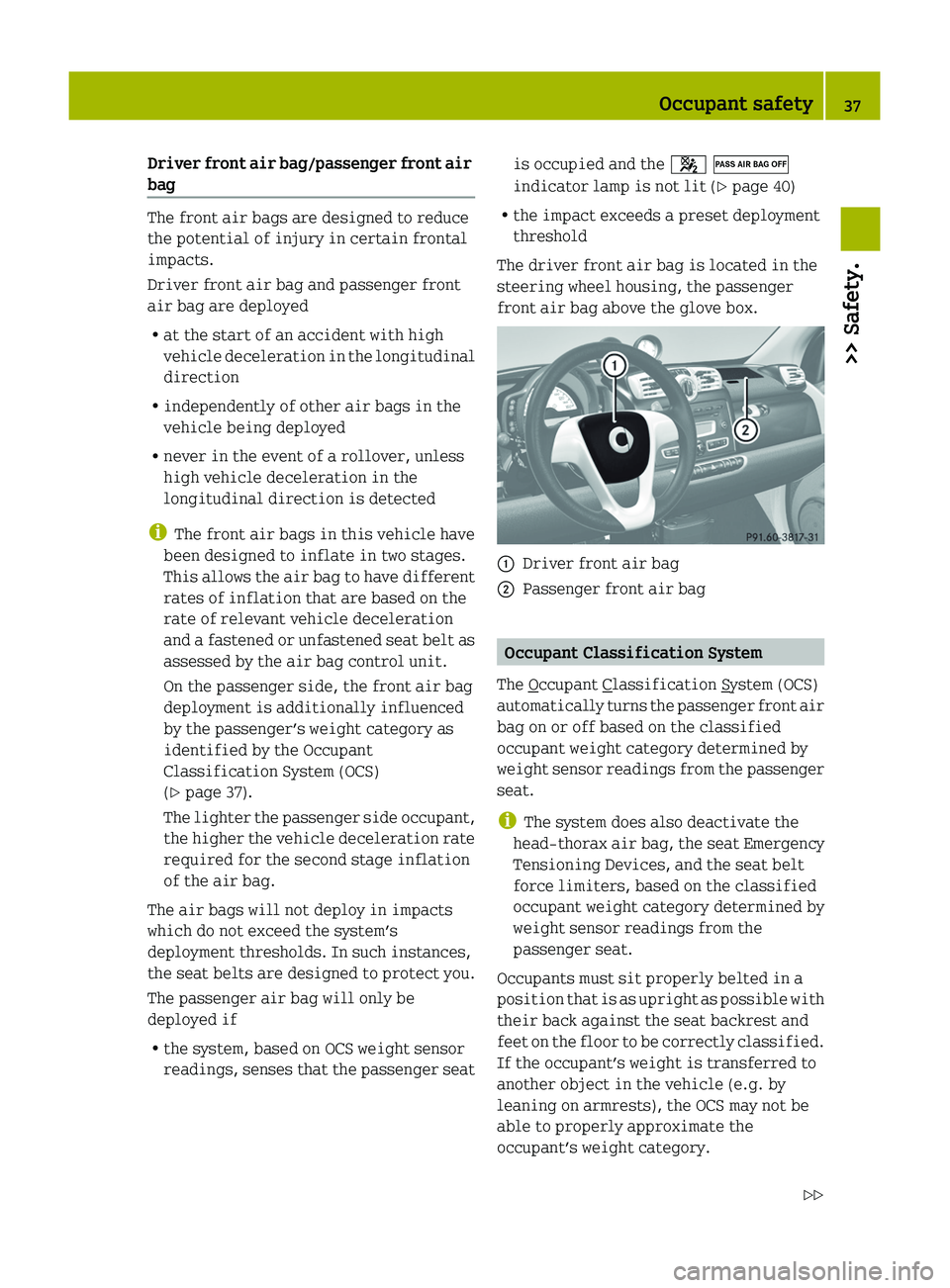
Driver front air bag/passenger front air
bag
The front air bags are designed to reduce
the potential of injury in certain frontal
impacts.
Driver front air bag and passenger front
air bag are deployed
R at the start of an accident with high
vehicle deceleration in the longitudinal
direction
R independently of other air bags in the
vehicle being deployed
R never in the event of a rollover, unless
high vehicle deceleration in the
longitudinal direction is detected
i The front air bags in this vehicle have
been designed to inflate in two stages.
This allows the air bag to have different
rates of inflation that are based on the
rate of relevant vehicle deceleration
and a fastened or unfastened seat belt as
assessed by the air bag control unit.
On the passenger side, the front air bag
deployment is additionally influenced
by the passenger’s weight category as
identified by the Occupant
Classification System (OCS)
( Y page 37).
The lighter the passenger side occupant,
the higher the vehicle deceleration rate
required for the second stage inflation
of the air bag.
The air bags will not deploy in impacts
which do not exceed the system’s
deployment thresholds. In such instances,
the seat belts are designed to protect you.
The passenger air bag will only be
deployed if
R the system, based on OCS weight sensor
readings, senses that the passenger seat
is occupied and the 007F 007B
indicator lamp is not lit ( Y page 40)
R the impact exceeds a preset deployment
threshold
The driver front air bag is located in the
steering wheel housing, the passenger
front air bag above the glove box.0046Driver front air bag0047Passenger front air bag
Occupant Classification System
The
Occupant Classification System (OCS)
automatically turns the passenger front air
bag on or off based on the classified
occupant weight category determined by
weight sensor readings from the passenger
seat.
i The system does also deactivate the
head-thorax air bag, the seat Emergency
Tensioning Devices, and the seat belt
force limiters, based on the classified
occupant weight category determined by
weight sensor readings from the
passenger seat.
Occupants must sit properly belted in a
position that is as upright as possible with
their back against the seat backrest and
feet on the floor to be correctly classified.
If the occupant’s weight is transferred to
another object in the vehicle (e.g. by
leaning on armrests), the OCS may not be
able to properly approximate the
occupant’s weight category.
Occupant safety37>> Safety.451_AKB; 3; 22, en-USd2ureepe,Version: 2.11.8.12009-07-27T09:36:34+02:00 - Seite 37Z
Page 40 of 216
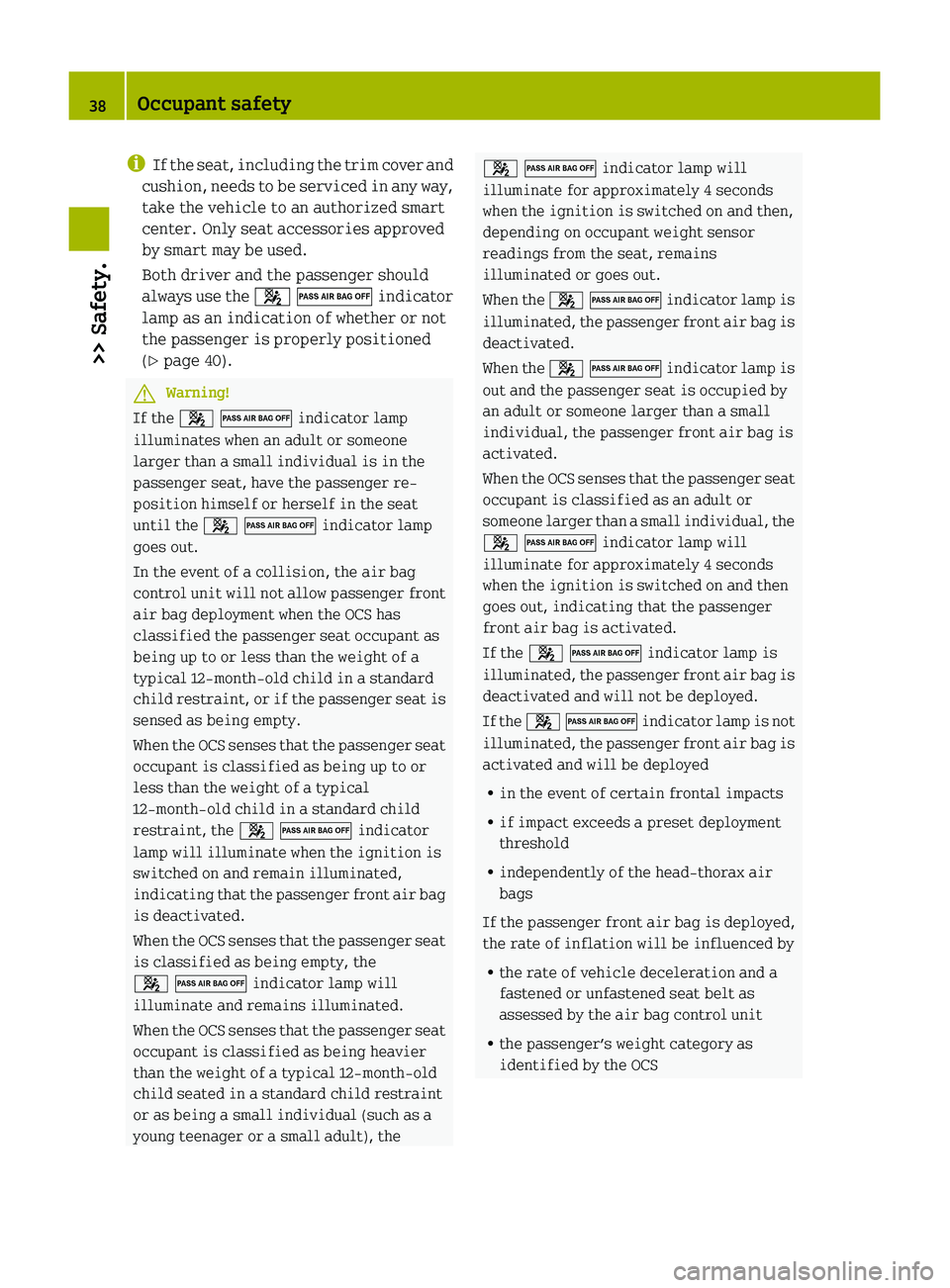
iIf the seat, including the trim cover and
cushion, needs to be serviced in any way,
take the vehicle to an authorized smart
center. Only seat accessories approved
by smart may be used.
Both driver and the passenger should
always use the 007F 007B indicator
lamp as an indication of whether or not
the passenger is properly positioned
( Y page 40).GWarning!
If the 007F 007B indicator lamp
illuminates when an adult or someone
larger than a small individual is in the
passenger seat, have the passenger re-
position himself or herself in the seat
until the 007F 007B indicator lamp
goes out.
In the event of a collision, the air bag
control unit will not allow passenger front
air bag deployment when the OCS has
classified the passenger seat occupant as
being up to or less than the weight of a
typical 12‑month‑old child in a standard
child restraint, or if the passenger seat is
sensed as being empty.
When the OCS senses that the passenger seat
occupant is classified as being up to or
less than the weight of a typical
12‑month‑old child in a standard child
restraint, the 007F 007B indicator
lamp will illuminate when the ignition is
switched on and remain illuminated,
indicating that the passenger front air bag
is deactivated.
When the OCS senses that the passenger seat
is classified as being empty, the
007F 007B indicator lamp will
illuminate and remains illuminated.
When the OCS senses that the passenger seat
occupant is classified as being heavier
than the weight of a typical 12‑month‑old
child seated in a standard child restraint
or as being a small individual (such as a
young teenager or a small adult), the
007F 007B indicator lamp will
illuminate for approximately 4 seconds
when the ignition is switched on and then,
depending on occupant weight sensor
readings from the seat, remains
illuminated or goes out.
When the 007F 007B indicator lamp is
illuminated, the passenger front air bag is
deactivated.
When the 007F 007B indicator lamp is
out and the passenger seat is occupied by
an adult or someone larger than a small
individual, the passenger front air bag is
activated.
When the OCS senses that the passenger seat
occupant is classified as an adult or
someone larger than a small individual, the
007F 007B indicator lamp will
illuminate for approximately 4 seconds
when the ignition is switched on and then
goes out, indicating that the passenger
front air bag is activated.
If the 007F 007B indicator lamp is
illuminated, the passenger front air bag is
deactivated and will not be deployed.
If the 007F 007B indicator lamp is not
illuminated, the passenger front air bag is
activated and will be deployed
R in the event of certain frontal impacts
R if impact exceeds a preset deployment
threshold
R independently of the head-thorax air
bags
If the passenger front air bag is deployed,
the rate of inflation will be influenced by
R the rate of vehicle deceleration and a
fastened or unfastened seat belt as
assessed by the air bag control unit
R the passenger’s weight category as
identified by the OCS38Occupant safety>> Safety.
451_AKB; 3; 22, en-USd2ureepe,Version: 2.11.8.12009-07-27T09:36:34+02:00 - Seite 38
Page 50 of 216
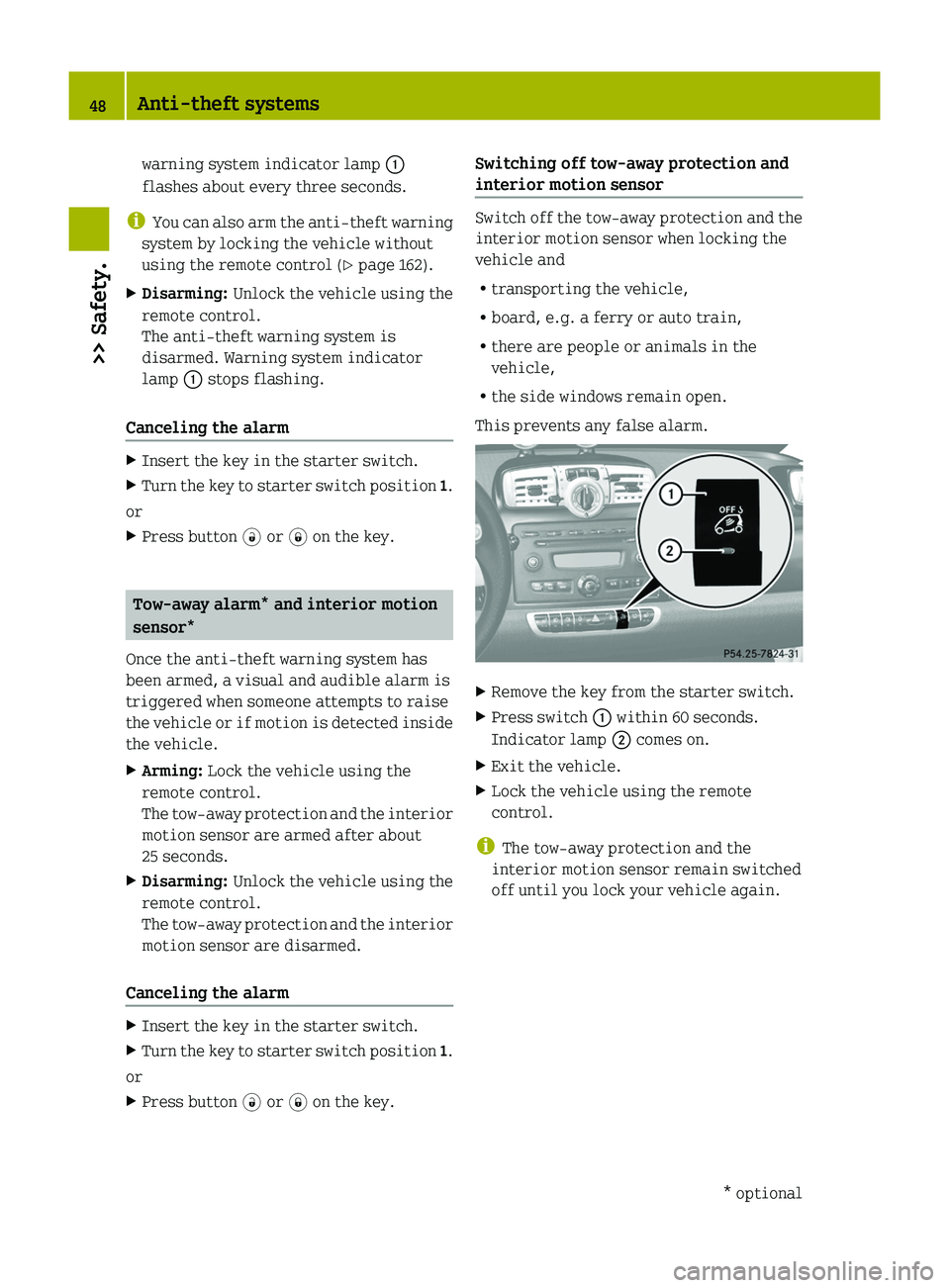
warning system indicator lamp 0046
flashes about every three seconds.
i You can also arm the anti-theft warning
system by locking the vehicle without
using the remote control ( Y page 162).
XDisarming: Unlock the vehicle using the
remote control.
The anti-theft warning system is
disarmed. Warning system indicator
lamp 0046 stops flashing.
Canceling the alarm
XInsert the key in the starter switch.XTurn the key to starter switch position 1.
or
XPress button 0034 or 0038 on the key.
Tow-away alarm* and interior motion
sensor*
Once the anti-theft warning system has
been armed, a visual and audible alarm is
triggered when someone attempts to raise
the vehicle or if motion is detected inside
the vehicle.
XArming: Lock the vehicle using the
remote control.
The tow-away protection and the interior
motion sensor are armed after about
25 seconds.XDisarming: Unlock the vehicle using the
remote control.
The tow-away protection and the interior
motion sensor are disarmed.
Canceling the alarm
XInsert the key in the starter switch.XTurn the key to starter switch position 1.
or
XPress button 0034 or 0038 on the key.Switching off tow-away protection and
interior motion sensor
Switch off the tow-away protection and the
interior motion sensor when locking the
vehicle and
R transporting the vehicle,
R board, e.g. a ferry or auto train,
R there are people or animals in the
vehicle,
R the side windows remain open.
This prevents any false alarm.
XRemove the key from the starter switch.XPress switch 0046 within 60 seconds.
Indicator lamp 0047 comes on.XExit the vehicle.XLock the vehicle using the remote
control.
i The tow-away protection and the
interior motion sensor remain switched
off until you lock your vehicle again.
48Anti-theft systems>> Safety.* optional451_AKB; 3; 22, en-USd2ureepe,Version: 2.11.8.12009-07-27T09:36:34+02:00 - Seite 48
Page 53 of 216
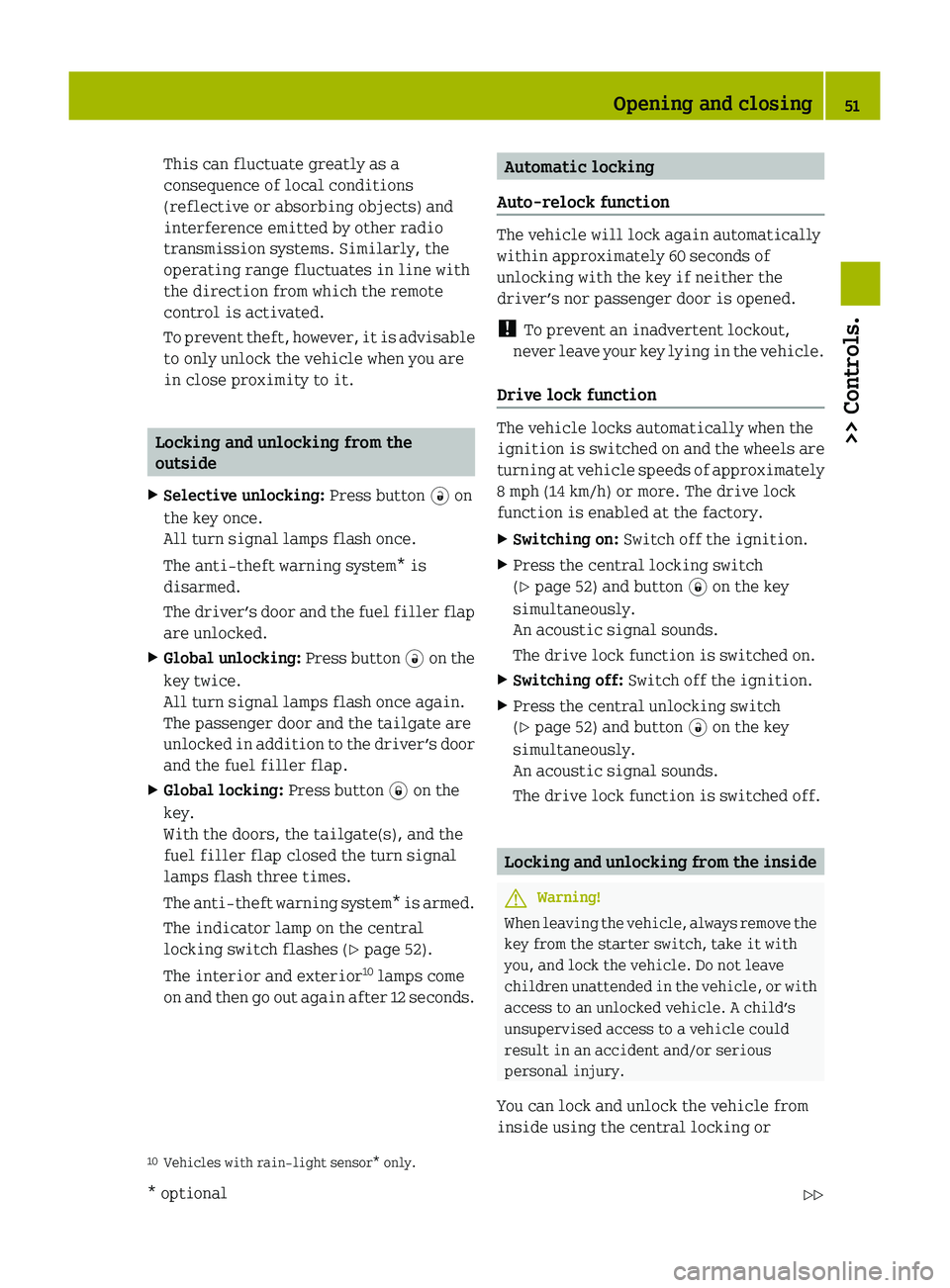
This can fluctuate greatly as a
consequence of local conditions
(reflective or absorbing objects) and
interference emitted by other radio
transmission systems. Similarly, the
operating range fluctuates in line with
the direction from which the remote
control is activated.
To prevent theft, however, it is advisable
to only unlock the vehicle when you are
in close proximity to it.
Locking and unlocking from the
outside
XSelective unlocking: Press button 0034 on
the key once.
All turn signal lamps flash once.
The anti-theft warning system* is
disarmed.
The driver’s door and the fuel filler flap
are unlocked.XGlobal unlocking: Press button 0034 on the
key twice.
All turn signal lamps flash once again.
The passenger door and the tailgate are
unlocked in addition to the driver’s door
and the fuel filler flap.XGlobal locking: Press button 0038 on the
key.
With the doors, the tailgate(s), and the
fuel filler flap closed the turn signal
lamps flash three times.
The anti-theft warning system* is armed.
The indicator lamp on the central
locking switch flashes ( Y page 52).
The interior and exterior 10
lamps come
on and then go out again after 12 seconds.Automatic locking
Auto-relock function
The vehicle will lock again automatically
within approximately 60 seconds of
unlocking with the key if neither the
driver’s nor passenger door is opened.
! To prevent an inadvertent lockout,
never leave your key lying in the vehicle.
Drive lock function
The vehicle locks automatically when the
ignition is switched on and the wheels are
turning at vehicle speeds of approximately
8 mph (14 km/h) or more. The drive lock
function is enabled at the factory.
XSwitching on: Switch off the ignition.XPress the central locking switch
( Y page 52) and button 0038 on the key
simultaneously.
An acoustic signal sounds.
The drive lock function is switched on.XSwitching off: Switch off the ignition.XPress the central unlocking switch
( Y page 52) and button 0034 on the key
simultaneously.
An acoustic signal sounds.
The drive lock function is switched off.
Locking and unlocking from the inside
GWarning!
When leaving the vehicle, always remove the
key from the starter switch, take it with
you, and lock the vehicle. Do not leave
children unattended in the vehicle, or with
access to an unlocked vehicle. A child’s
unsupervised access to a vehicle could
result in an accident and/or serious
personal injury.
You can lock and unlock the vehicle from
inside using the central locking or
10 Vehicles with rain-light sensor* only.Opening and closing51>> Controls.* optional451_AKB; 3; 22, en-USd2ureepe,Version: 2.11.8.12009-07-27T09:36:34+02:00 - Seite 51Z